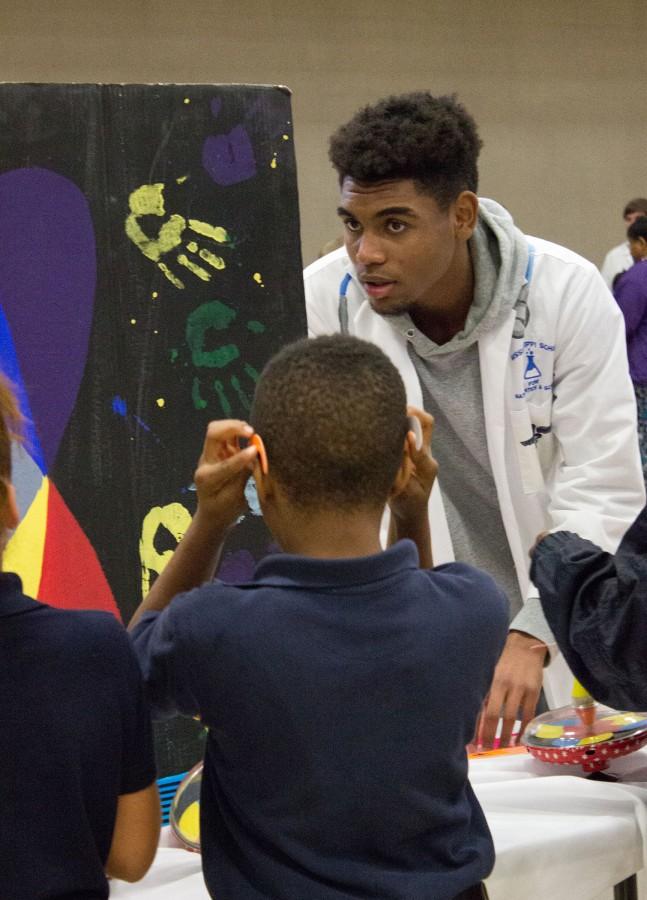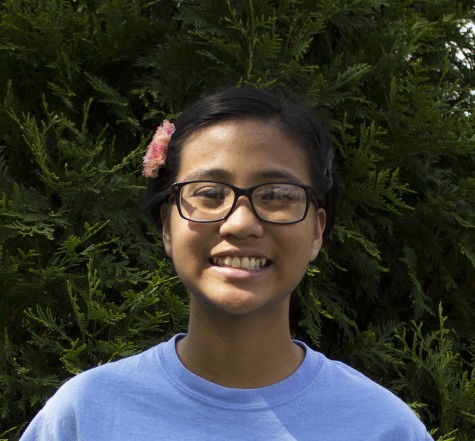MSMS Hosts Annual Science Carnival
Gianni Stennis, an MSMS senior, presenting the “color” station at the Science Carnival.
November 2, 2015
The annual MSMS Science Carnival had no shortage of excitement and madness that accompanies showcasing diverse scientific concepts and experiments to hundreds of regional elementary students in one morning and afternoon.
On Tues. Oct. 27, each student at MSMS took a day off from classes to present the Science Carnival, held at Pohl Gym on the MUW campus. Coordinator Amber Lynn Moore worked hard to ensure that schools are invited, supplies are ordered, and all MSMS students are assigned a specific job. Jobs included presenters, set up/tear down crew, guides, and greeters.
After the greeters welcomed the elementary students through the door, the students were divided into groups and led by the guides to each station where the presenters showcased their topic. Afterwards, the set up/tear down crew helped return the gym back to normal. Moore believes this year’s Science Carnival went well and that it “gets better each year.”
The “carnival” portion of the Science Carnival consists of four rows of eight stations. Each station is equipped with two MSMS students as presenters and materials to demonstrate basic scientific concepts about inertia, electricity, color, natural selection, microbiology, the metric system, properties of water, and hydrophilic/hydrophobic materials. Some stations utilize a water lock, plates pulled out from under a tablecloth, a “lightning” machine, and a color wheel.
The Science Carnival is a learning experience for everyone involved, as MSMS biology teacher Bill Odom stated, “It is phenomenal when you have multiple age groups learning together: young kids, y’all (MSMS students), and us.”
Odom enjoys the station titled “Now You See It, Now You Don’t,” which shows the basic concepts of natural selection by showing different patterned butterflies against various backgrounds. When a butterfly pattern matches its background, it “turns invisible.” Odom believes this station “gets (the elementary students) to thinking about something they can grasp.”
Junior Landry Filce, a presenter for the metric system, stated, “I sure did have fun because I liked seeing the children learn. It was definitely worth it.” For senior Dajah Carter, a presenter for the color station, her favorite part of the Science Carnival was “making the kids question everything they thought they knew.”
Elizabeth Morgan, chemistry instructor, enjoys how “little students get to look up to our students” like “peer-to-peer mentors.” Not only do elementary students learn, but high school students also learn the nature of the jobs of their own teachers. Morgan’s favorite parts of the Carnival are the comments from MSMS students. “Every year, at least one student has said, ‘Dr. Morgan, how do you do that all day long?’ or ‘I’m so thirsty; how do you talk that much?’”
Next year, the MSMS hopes to improve the science carnival by finding better ways to accommodate elementary schools who could not attend due to the time constraints. In addition, Moore stated, “there is always room for improvement, and I welcome all suggestions on ways to improve and welcome new ideas.”
Moore said the Science Carnival is a “wonderful outreach opportunity for MSMS” and “a way that we implement part of the MSMS mission: aggressive outreach programs that impact students across Mississippi.”









